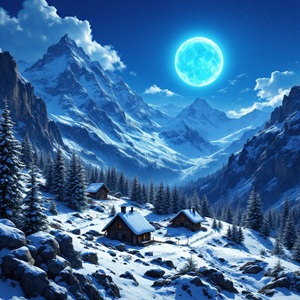August, 1831. Across the Atlantic and Pacific, people looked up at the sky and froze. The sun had turned blue.
Not a pale winter blue, not the soft blue of a calm afternoon but a deep, unnatural, eerie blue.
A sky so strange it left witnesses describing it in journals, letters, and sermons. What caused it?

In the summer of 1831, something extraordinary darkened the skies. A colossal volcanic eruption sent vast clouds of sulfur gas high into the atmosphere, scattering sunlight in eerie hues of green, purple, and blue. Daylight itself seemed strange and unreal. Sunlight barely touched the ground, crops withered in the fields, and famine quietly spread across the Northern Hemisphere.
Temperatures dropped to 1 degree Celsius, turning summer into a chill that felt more like winter.
German composer Felix Mendelssohn, journeying through the Alps, could hardly describe the scene. He wrote in his journal, “It is as cold as in winter, there is already deep snow on the nearest hills.” Even the mountains themselves seemed caught off guard by this unusual season.

For nearly two centuries, scientists puzzled over which volcano had caused such a dramatic global disruption. Now, new research published in Proceedings of the National Academy of Sciences points to the culprit. Zavaritskii caldera, a remote volcano on Simushir Island in the Kuril archipelago, a disputed region between Russia and Japan.
“For many of Earth’s volcanoes, particularly those in remote regions, we have very limited understanding of their eruptive history,” explained volcanologist Will Hutchison of the University of St Andrews. Simushir Island, once home to a Soviet submarine base, left behind almost no historical records only a handful of diaries from ships that passed nearby. This obscurity made Zavaritskii a mysterious suspect for centuries.

Earlier theories had blamed tropical eruptions, including the Babuyan Claro volcano in the Philippines. But Hutchison and his team examined Greenland ice cores and discovered sulfur fallout six-and-a-half times greater than in Antarctica, indicating the eruption had originated in the Northern Hemisphere. Microscopic shards of volcanic glass, barely a tenth the width of a human hair, matched chemically with rock samples from the Kurils.
The eruption had been immense, releasing an estimated 13 million metric tons of sulfur into the atmosphere close enough to devastate Japanese crops, yet distant enough to remain largely unrecorded.
Tracking the link between the ash in Greenland and the rocks on Simushir took years, Hutchison later recalled. When they finally made the connection, he called it “a genuine eureka moment.”
So next time you glance at the sun remember, 1831 was the year the sun turned blue, and the world itself seemed to hold its breath.


Charles R
I had not heard of this one. In Indonesia in 1816 The Tamobra eruption casued lots of famine in Europe. The more famous in 1883, Krakatoa in Indonesia did the same. Made for some great painting landscapes. Los Angeles recieved about 38 inches of rain in a few months, their highest recorded. God help us in Yellowstone goes off again.
Kevin S
Thanks for sharing. Very cool info.
-Kajrak